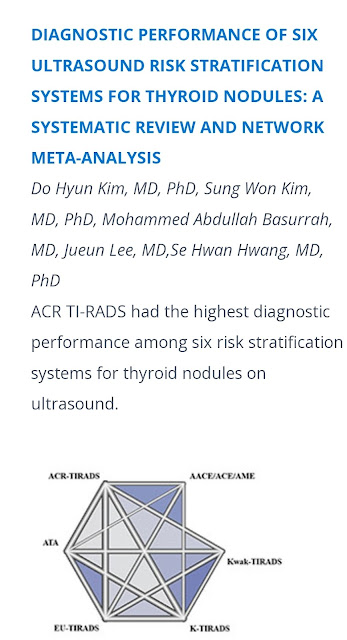By Amerigo Allegretto, AuntMinnie.com staff writer
February 9, 2023 -- The American College of Radiology (ACR) TI-RADS system is best for risk stratification of thyroid nodules found on ultrasound, according to a Korean study published February 8 in the American Journal of Roentgenology.
Researchers led by Dr. Do Hyun Kim, PhD, from the Catholic University of Korea in Seoul compared six different risk stratification systems in a meta-analysis that encompassed nearly 50,000 patients. They found that the ACR's Thyroid Imaging Reporting and Data System (TI-RADS) delivered the highest diagnostic performance.
"This comparative evaluation of risk stratification systems for thyroid nodules can inform decisions regarding system implementation, as well as aid future system updates," Kim and colleagues wrote.
Risk stratification systems are used to evaluate thyroid nodules on ultrasound. Different systems use varying approaches to classify levels of suspicion for malignancy. This can lead to variable performance.
To see which system was the best, Kim et al wanted to put these different risk stratification systems to the test in a meta-analysis that included 39 studies with 49,661 patients. All studies included had either fair (n = 17) or good (n = 22) image quality. The risk stratification systems analyzed in the study included the following:
- American Association of Clinical Endocrinologists/American College of Endocrinology/Associazione Medici Endocrinologi (AACE/ACE/AME)
- ACR TI-RADS
- American Thyroid Association (ATA)
- European Thyroid Association Thyroid Imaging Reporting and Data System (EU-TIRADS)
- Korean Thyroid Association/Korean Society of Thyroid Radiology Thyroid Imaging Reporting and Data System (K-TIRADS)
- Thyroid Imaging Reporting and Data System developed by Kwak et al. (Kwak TIRADS)
The authors used the surface under the cumulative ranking curve (SUCRA) to rank the systems in terms of sensitivity, specificity, and accuracy. Although all systems had varying advantages and disadvantages when it came to low-risk versus high-risk findings, they found that ACR TI-RADS had the highest overall metrics, followed by K-TIRADS.
| Performance of thyroid ultrasound risk stratification systems | ||||||
| EU-TIRADS | AACE/ACE/AME | ATA | Kwak TI-RADS | K-TIRADS | ACR TI-RADS | |
| Sensitivity | 5% | 20% | 39% | 67% | 81% | 89% |
| Specificity | 8% | 27% | 33% | 62% | 78% | 93% |
| Accuracy | 14% | 66% | 30% | 50% | 68% | 72% |
The researchers suggested that the higher performance of ACR TI-RADS and Kwak TIRADS are due to their being score-based systems and not pattern-based, the latter of which provide "less precise" estimates of malignancy risk.
ACR TI-RADS, however, includes an initial assignment of a varying number of points in multiple categories before calculating the sum of these points across categories to weigh certain findings. In addition, this method considers commonly encountered thyroid nodule characteristics, the study authors noted. Also, ACR TI-RADS recommends that follow-up ultrasound be performed in nodules smaller than the size cutoffs in the mildly, moderately, and highly suspicious categories.
In an accompanying editorial, Dr. Luyao Shen from Stanford University in California wrote that although ACR TI-RADS "can be cumbersome" to use compared with other guidelines, its structured system helps achieve consistency among readers. Shen also noted the system's larger size thresholds for biopsy recommendations, along with options for active surveillance for smaller nodules with suspicious features.
"Strong evidence supports ACR TI-RADS as the preferred system to risk stratify thyroid nodules," Shen wrote.


Không có nhận xét nào :
Đăng nhận xét